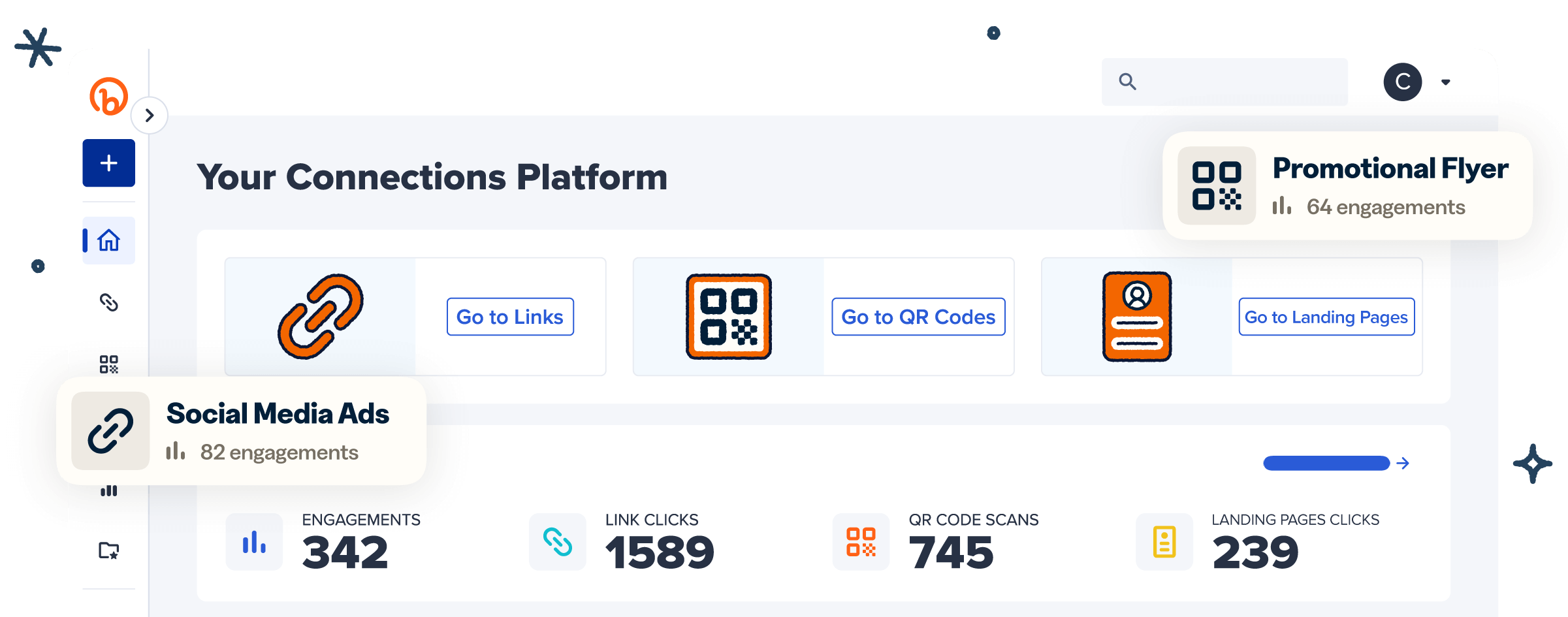The “last mile” may come at the end of the delivery process, but it shouldn’t come last in your priorities. This critical touchpoint can make or break customer trust. And yet, it’s often where things go wrong. Late packages, incorrect updates, and a lack of transparency can all frustrate customers and erode the chances of repeat purchases.
But it doesn’t have to be like that. With QR Codes, you can transform the last mile from a stumbling block to a competitive differentiator. These versatile tools can streamline order fulfillment, simplify tracking, and ensure accurate delivery confirmations—all while giving customers the real-time updates they expect.
Here’s a closer look at how QR Codes can take your delivery strategy to the next level.
Note: The brands and examples discussed below were found during our online research for this article.
How do QR Codes work for delivery confirmation?
Quick Response (QR) Codes are 2D barcodes that can link to a wide variety of digital assets, taking customers straight to the information they need with just a quick smartphone scan. They are incredibly useful for replacing manual, paper-based processes and capturing data instantly. In the context of delivery confirmation, QR Codes have several use cases:
- Streamline tracking and updates: Include QR Codes on packages to let drivers confirm shipments and initiate real-time tracking, giving customers instant updates on their orders.
- Automate inventory management: Use QR Codes for inventory tracking to monitor stock levels, speed up restocking, and ensure accuracy.
- Add security to package exchanges: Provide customers with a QR Code for delivery drivers to scan, confirming delivery and improving trust in the process.
- Collect customer feedback: Place QR Codes on receipts to encourage instant feedback after delivery, giving you valuable insights to refine your service.
- Offer personalized post-purchase perks: Brands can add QR Codes for e-commerce to package inserts to share exclusive discounts, product recommendations, or premium content.
Key benefits of using QR Codes in delivery confirmation
The last mile is notoriously the least efficient puzzle piece of supply chain management, accounting for an average of 28% of total delivery costs. QR Codes are a simple but highly effective mechanism to directly tackle these inefficiencies—while also building all-important customer loyalty. Here’s how:
Improved accuracy
Research shows that 73% of online retailers and shipping providers struggle to offer real-time tracking to their customers. This is a huge missed opportunity. Not only is a lack of real-time tracking bad for customer trust, but it can also lead to costly errors. When logistics employees have to log on to a computer and input data manually—or worse, use paper forms to initiate an order—errors are almost inevitable.
QR Codes eradicate this issue. With just a scan of the code on the shipping label, the driver triggers an instant update to the customer order management system, ensuring instantaneous tracking accuracy.
But what happens if a customer makes an error when entering their delivery address? With Dynamic QR Codes, this is easy to correct. These codes are editable on the backend, even after they’ve been printed. If a customer requests a change to their delivery details post-order, you can simply update their order number in your system. The driver will then have the most current information, ensuring a smooth and accurate delivery process.
Increased customer trust
E-commerce brands and logistics companies can enhance customer trust by using QR Codes as a secure order verification tool. After customers place an order, you can send them a QR Code to be scanned by the delivery driver at the point of handover.
Rather than relying solely on the name on the package, the driver scans the QR Code to verify the recipient’s identity. This extra layer of security ensures that the right person receives the right package, giving peace of mind to both your business and your customers.
Updates for customers and businesses
QR Codes are clearly great for initiating and ending the last-mile process, but what about the all-important middle? When it comes to real-time tracking, QR Codes again offer a seamless and intuitive solution.
By sending QR Codes to customers through email or text, you give them an easy way to track the delivery status of their package. This improves their experience, enhances transparency, and offers a sense of control over their delivery.
At the same time, real-time tracking helps your business by reducing the number of customer service inquiries you’ll receive about package status. Plus, this data can offer valuable insights into your operational processes, giving you the insights you need to identify potential bottlenecks and areas for improvement.
Reduced fraud risks
With delivery scams on the rise across the globe, customers will greatly appreciate the effort you put into enhancing secure deliveries.
You can use QR Codes to strengthen customer identity verification by linking QR Codes to URLs with a unique PIN number that only the customer has access to. The driver then requests the PIN at delivery, reassuring both the delivery personnel and your customers that the package is in the right place, with the right person.
Cost-effective solution
For all their game-changing benefits, QR Codes are actually very affordable, offering a low-risk, high-reward springboard towards delivery digitization. Their cost-effectiveness is matched by their flexibility—these codes can link to any online destination, giving you complete control over the customer experience.
What’s more, platforms like Bitly offer many integrations, allowing you to connect QR Codes to your existing logistics systems with just a few clicks. This means you can quickly embed QR Codes into your operations without the need for complex or expensive infrastructure changes.
QR Codes vs. barcodes for delivery confirmation
You might be thinking, “Can’t delivery barcodes do everything QR Codes do?” The answer is . . . not quite. Here’s a look at why QR Codes are the superior choice for optimizing your supply chain.
- Data capacity: QR Codes outshine barcodes with their ability to store considerably more information, from real-time updates to interactive links, whereas barcodes are limited to just 25 characters, offering less flexibility.
- Scannability: QR Codes can be scanned both horizontally and vertically, making them faster and more versatile. Barcodes, on the other hand, can only be scanned from one direction.
- Scanning devices: One of the biggest advantages of QR Codes is that they can be scanned by mobile devices—no need for extra equipment. Barcodes require specialized scanners, which adds complexity and costs.
- Dynamic updates: Unlike barcodes, which are static once printed, Dynamic QR Codes can be updated in real time, allowing businesses to keep delivery tracking and confirmations accurate and up to date.
Practical applications of QR Codes in delivery processes
Ready to unleash the benefits of QR Codes for deliveries? Here’s a look at where and how to use them.
Last-mile delivery
Streamline last-mile logistics by sharing unique QR Codes with your customers via email after order confirmation. Delivery drivers will then scan this code upon package exchange to validate the recipient’s identity.
Proof of delivery for businesses
You can enhance the reliability of your delivery process by using QR Codes to confirm proof of delivery as well. Link the QR Codes to your internal tracking system via integration or API, then set it up so that when the code is scanned, your system will automatically update the shipment to a “delivered” status, giving you an accurate record for reference.
Customer self-service tracking
Give your customers the power to track their deliveries whenever they want. QR Codes can link directly to a tracking information page, allowing them to monitor their package’s progress without contacting your customer support team.
How to implement QR Codes for delivery confirmation
Before you start rolling out QR Codes, you first need to create them. Here’s how to make QR Codes to streamline your delivery processes:
Choose the right QR Code generator
Opt for an intuitive, well-known QR Code solution platform. It should be easy to use and have all the features you need to scale—Dynamic codes, integrations with logistics platforms and CRMs, customization options, and bulk QR Code generation capabilities.
Bitly’s QR Code generator is a great option that offers an impressive range of use cases, customization options, and scaling features, as well as an extensive integration marketplace. With Bitly’s Dynamic QR Codes, you can update the linked URL or content in real time, without regenerating the code, making it easy to keep customers informed with the latest tracking info.
Plus, you can track QR scans by location (city/country), time, and even device type for detailed insights into how customers are using them. This can help you refine your strategy and processes over time for better efficiency and engagement.
Design codes for easy scanning
Once you’ve chosen a platform, it’s time to focus on design. Since your QR Codes will be scanned by various types of devices, sometimes in outdoor or low-light conditions, it’s important to ensure they’re easy to scan and consistently work correctly. Here are some design tips to keep in mind as you create your QR Code:
- High contrast: Use high-contrast colors for the background and foreground of your QR Codes to increase visibility in different lighting conditions and aid scanning.
- Branding: To build trust and reinforce your brand, consider adding your logo to the center of the QR Code and customizing it with your brand colors.
- Clear call-to-action (CTA): Don’t leave customers guessing. Include a clear CTA, such as “Show me to the delivery driver for order verification” or “Scan me for tracking updates,” depending on the code’s function.
Train delivery personnel
As all leaders know, communication is the bedrock of successful change management. Before and during QR Code rollout, it’s crucial to equip your drivers and logistics staff with the knowledge they need to embrace the new solution. Use a combination of emails, step-by-step training guides, and videos to help your people learn how to use these codes in different contexts.
Embrace QR Codes for secure delivery confirmation
As customers demand faster, more reliable deliveries with detailed tracking, QR Codes are an essential tool for bringing clarity and efficiency to the last mile. They bridge the gap between operational efficiency and customer satisfaction, offering a simple way to improve transparency, mitigate errors, and streamline logistics.
Bitly makes it easy to put QR Codes to work across your delivery ecosystem. Through the platform’s intuitive interface, you can generate, customize, and track QR Codes tailored to your logistics needs.
From real-time inventory updates to error-free order fulfillment, Bitly’s Dynamic QR Codes ensure every step of the process is connected and visible—not just to your team but to your customers too.
Are you ready to take your deliveries to the next level? Discover the Bitly difference and find the best plan for your business today.




